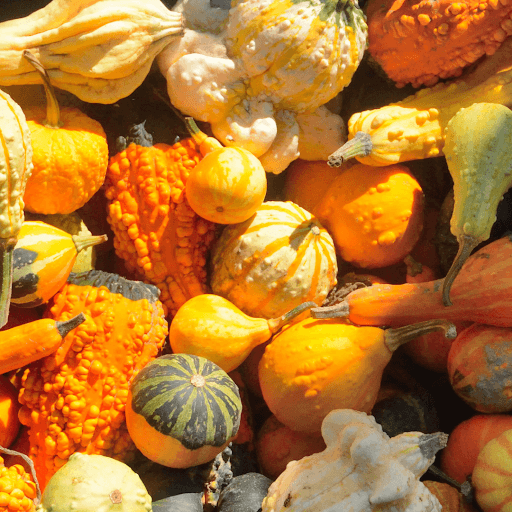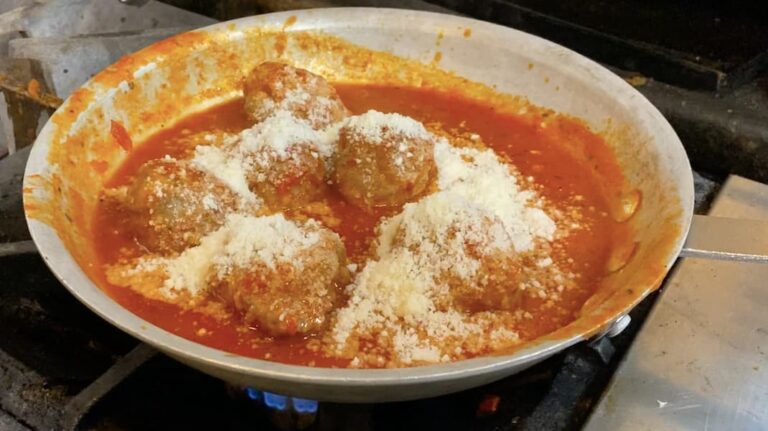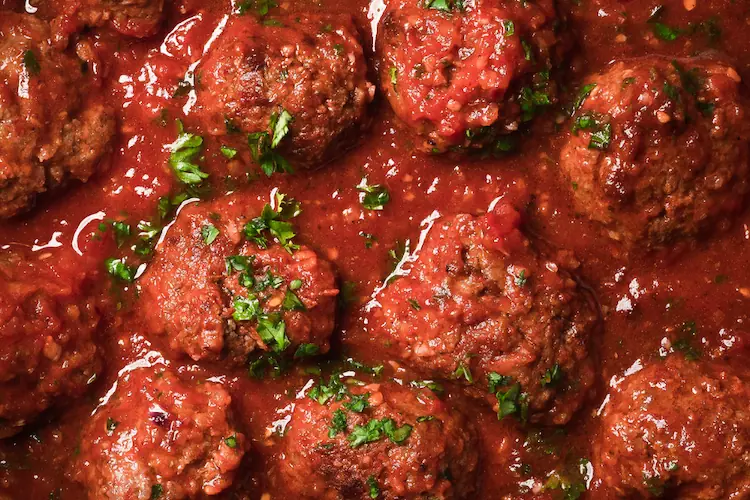Winter squashes are a staple in my kitchens, especially during the cooler months.
I always make sure to pick up whatever is available at my local Farmer’s Market so I can enjoy them at peak freshness.
Two of the most popular varieties (and my favorites!) are acorn squash and butternut squash.
While both belong to the family Cucurbita moschata, these squashes offer distinct flavors, textures, and culinary uses.
Today, I’m here to guide you through the differences in flavor, texture, nutrition, and much more.
What Are Winter Squashes?
Winter squashes, including acorn squash and butternut squash, are varieties of squash harvested in late summer and fall and stored for use throughout the winter. They feature hard rinds and seeds, making them ideal for long-term storage at room temperature. Some other popular winter squashes include spaghetti squash, delicata squash, kabocha squash, and pumpkin.
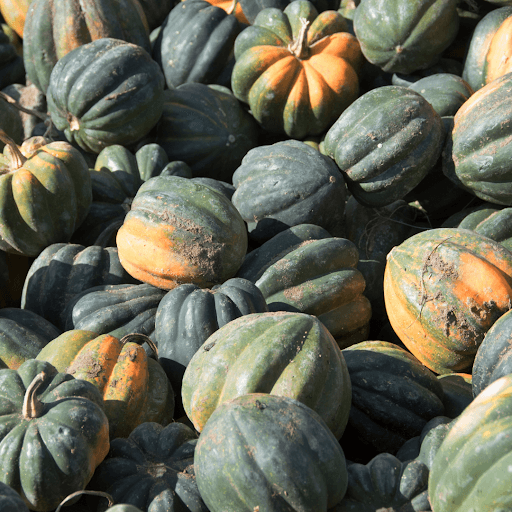
Acorn Squash: Overview
Appearance: Acorn squash is small in size, with a round shape, dark green skin, and ridges. Some acorn squashes have light-green stripes or even orange skin, but most have a deep green hue.
Flavor and Texture: Acorn squash has a mild, nutty flavor with a slight sweetness. The texture is more fibrous than butternut squash, making it a bit less creamy when cooked. The flesh is a vibrant orange or yellow-orange and works well in both savory and sweet dishes, such as when paired with maple syrup or brown sugar.
Nutritional Information:
- High in dietary fiber, which supports digestion
- A good source of vitamin C and beta carotene, which benefit the immune system and eye health
- Contains small amounts of vitamin B and potassium
Common Uses:
- Roasting with olive oil, salt, and a little butter
- Stuffed with wild rice, whole grains, or savory fillings like ground meat
- Pureed into soups or added to salads for extra texture
Seasonality: Acorn squash is typically available in grocery stores from late summer through the winter months. It stores well at room temperature for a long time due to its hard rind.
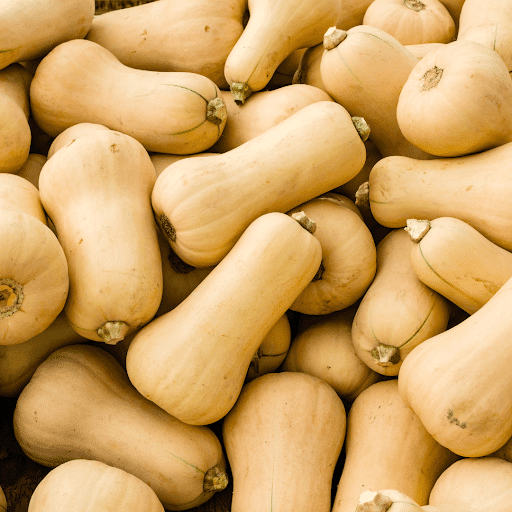
Butternut Squash: Overview
Appearance: Butternut squash has a distinctive shape, resembling a bell or miniature pumpkin with a long neck. It has smooth, tan skin and vibrant orange flesh inside.
Flavor and Texture: Known for its sweet, nutty flavor, butternut squash is often considered one of the sweetest winter squashes. Its flesh is creamy and smooth when cooked, making it an excellent choice for soups, roasted vegetables, and even pies. Its texture is more versatile compared to acorn squash, thanks to its dense, creamy flesh.
Nutritional Information:
- Rich in vitamin A, contributing to eye health and skin glow
- A good source of vitamin C, dietary fiber, and potassium
- Contains beta carotene, known for its antioxidant properties
Common Uses:
- Roasting with olive oil until golden brown
- Pureeing into soups or mashed with sweet potatoes for a creamy side dish
- Used as a base for savory dishes like risotto or roasted alongside whole grains like farro or quinoa
Seasonality: Butternut squash is available from late summer to winter, with a long storage life at room temperature. Farmers markets often offer butternut squash throughout the fall.
How to Choose Between Acorn and Butternut Squash
When deciding which squash to use, consider the following:
- For Soups & Purees: Butternut squash’s smooth texture and sweet flavor make it the ideal choice.
- For Stuffed Dishes: Acorn squash’s natural bowl shape is perfect for stuffing with grains or vegetables.
- For Roasting: Both squashes roast well, but butternut squash offers a creamier texture, while acorn squash maintains more structure.
- For New Cooks: If it’s your first time cooking with squash, butternut squash is often considered easier to work with due to its smooth skin and creamy flesh.
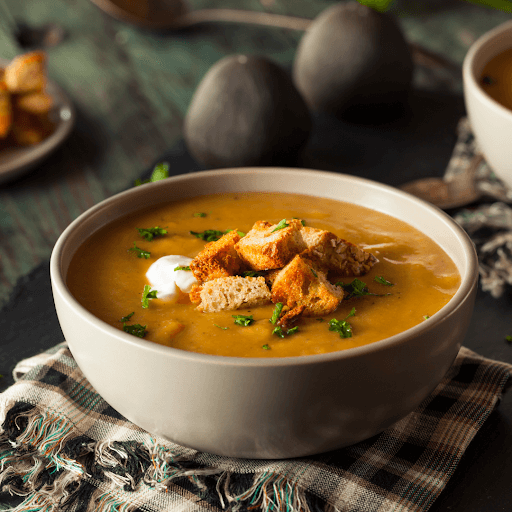
Cooking Methods: Different Ways to Prepare Winter Squash
Winter squashes like acorn and butternut squash are incredibly versatile. Below are some of the best ways to cook them:
- Roasting: Cut squash in half, remove seeds, and roast cut sides down on parchment paper with olive oil until golden brown and tender.
- Stuffing: Acorn squash can be hollowed out and stuffed with savory fillings such as quinoa, wild rice, or vegetables.
- Pureeing: Butternut squash is excellent for pureeing into soups or mashes, thanks to its creamy texture.
- Mashing: Combine butternut squash with sweet potatoes for a nutrient-dense, sweet mash.
Nutritional Information: Acorn vs. Butternut Squash
Both acorn and butternut squashes are packed with essential vitamins and minerals. Here’s a quick nutritional comparison:
Acorn Squash (1 cup, cooked):
- Calories: 115
- Dietary Fiber: 9g
- Vitamin C: 20% of Daily Value
- Potassium: 25% of Daily Value
- Beta Carotene: Moderate
Butternut Squash (1 cup, cooked):
- Calories: 82
- Dietary Fiber: 7g
- Vitamin A: 457% of Daily Value
- Vitamin C: 35% of Daily Value
- Beta Carotene: High
Frequently Asked Questions
Q: Can you eat the skin of acorn or butternut squash?
A: Acorn squash skin is edible but often left uneaten due to its thick, bumpy texture. Butternut squash skin is thinner and can be eaten, but it’s typically peeled for smoother texture in recipes.
Q: What’s the best way to store winter squash?
A: Both acorn and butternut squashes should be stored at room temperature in a cool, dry place. They can last for several months if stored correctly.
Q: What are some good flavor pairings for winter squash?
A: For acorn squash, flavors like brown sugar, maple syrup, and a little butter enhance its natural sweetness. Butternut squash pairs well with savory ingredients like olive oil, pumpkin
Q: Are acorn and butternut squash similar to pumpkin?
A: Yes, acorn and butternut squash are part of the same winter squash family as pumpkins. In terms of flavor, butternut squash is closer to sugar pumpkins due to its sweetness, whereas acorn squash is more mild and nutty. All of these squash varieties, including pie pumpkins, can be used interchangeably in many recipes like soups, purees, or roasted dishes.
Q: How do I cut through the tough skin of winter squash?
A: Winter squashes have a tough exterior, so use a sharp knife and a stable cutting board. Start by slicing off the stem end to create a flat surface, then carefully cut the squash in half. You may want to microwave the squash for a minute or two to soften the skin slightly, making it easier to cut through.
Q: Can acorn or butternut squash be used in desserts?
A: Yes! Both acorn and butternut squashes can be used in desserts. Butternut squash, with its sweet flavor and creamy texture, is perfect for pies, tarts, and even pumpkin pie alternatives. Acorn squash can be roasted with maple syrup or brown sugar to bring out its sweet notes, making it a good choice for sweet side dishes or dessert applications.
Seasonal Availability and Farmers Markets
Both acorn and butternut squash are readily available in grocery stores and farmers markets, especially during the fall and winter months. They are harvested in late summer and can be found through the winter.
Shopping at a farmers market ensures you get the freshest produce, and it’s a great way to find less common varieties like red kuri squash, blue hubbard, or sweet dumpling squash.
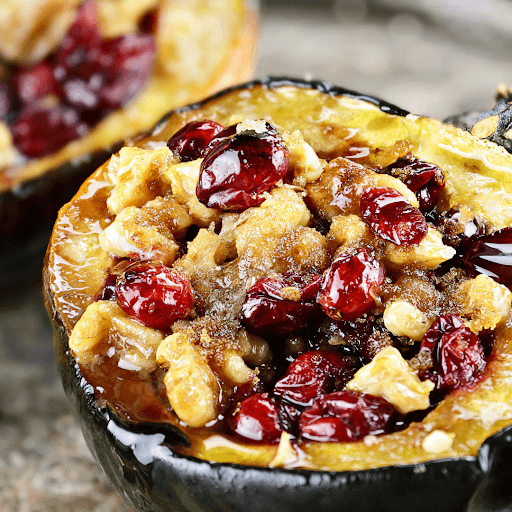
Cooking Tips for Winter Squashes
Here are a few tips to get the most out of your winter squash dishes:
- Roast Squash Seeds: Don’t throw away the seeds! Whether you’re cooking acorn, butternut, or even pie pumpkins, save the seeds and roast them. Simply rinse, dry, toss with olive oil, and roast at 300°F until golden brown. Roasted squash seeds are a nutritious snack and a good source of dietary fiber.
- Pair with Whole Grains: Winter squashes pair beautifully with whole grains like wild rice or quinoa. The nutty flavor of grains complements the sweetness of butternut and the mild flavor of acorn squash.
- Add to Savory Dishes: Butternut squash is ideal for savory dishes like roasted vegetable medleys or pasta with sage and brown butter. Acorn squash can be stuffed with savory fillings like ground turkey, vegetables, and herbs for a hearty meal.
- Use Different Methods: Explore various methods for cooking squash, such as steaming, roasting, or grilling. Roasting brings out caramelized flavors, while steaming can make for a more delicate texture that works well in soups.
Lesser-Known Squash Varieties
While acorn and butternut squash are well-known, there are other varieties of winter squash worth trying:
- Kabocha Squash: This Japanese variety has a sweet flavor similar to sweet potatoes and a dense texture that works well in both savory and sweet dishes.
- Buttercup Squash: With a rich, creamy texture and nutty flavor, buttercup squash is a great substitute for acorn squash in many recipes.
- Honeynut Squash: A smaller, sweeter cousin of butternut squash, honeynut squash is perfect for roasting and is often considered the sweetest winter squash.
- Delicata Squash: Known for its thin, edible skin and mild flavor, delicata squash is ideal for roasting with little prep time required.
- Banana Squash: This large squash variety has a sweet, smooth texture, making it perfect for large-scale soups or mashes.
Which Squash Should You Choose?
Ultimately, the choice between acorn squash and butternut squash comes down to your personal taste preferences and the dish you’re preparing.
If you’re looking for a mildly sweet, nutty flavor and a squash that holds its shape when roasted or stuffed, acorn squash is your go-to.
But if you prefer a sweeter, creamier texture for soups, purees, and even desserts, butternut squash is the ideal choice.
Both squashes are excellent sources of vitamins, minerals, and dietary fiber, making them a nutritious addition to your meals throughout the winter months.
Whether you’re roasting pieces of squash with olive oil or making a savory wild rice stuffing, these versatile vegetables play a crucial role in fall favorites and comfort foods.
No matter which variety you choose, winter squashes like acorn and butternut are a great way to add flavor, nutrition, and color to your autumn and winter dishes. So grab your cutting board and sharp knife, and get ready to savor the nutty flavor of acorn squash or the sweet, creamy texture of butternut squash this season!
Happy cooking!

